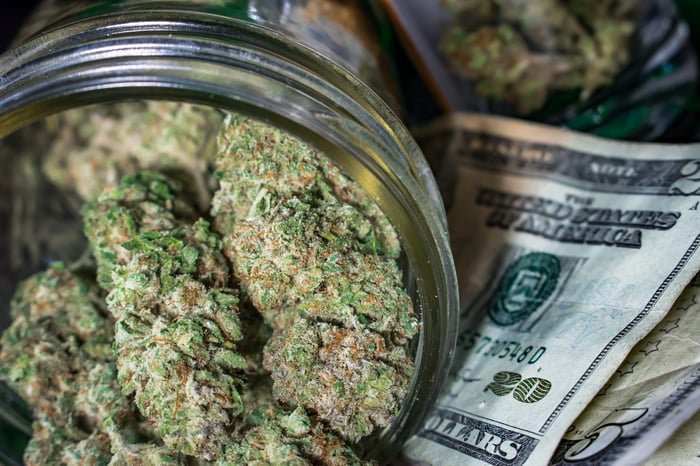Though spring only recently arrived, marijuana stocks have been flowering for a good two years. Cannabis research firm ArcView has forecast a compound annual growth rate of 28% for the legal weed industry in North America through 2021, leading to what could amount to almost $25 billion in annual sales if these estimates prove accurate.
Growing from less than $7 billion in annual sales to almost $25 billion between 2016 and 2021 in North America would be one heck of a feat for an industry that's still illegal in every country except Uruguay. Of course, that could soon change. Canada appears to be on the verge of legalizing adult-use marijuana by this summer, paving the way for recreational cannabis sales to commence by August or September. This should add $5 billion or more in annual sales, assuming approval.
As a result of marijuana's expansion potential, pot stock valuations -- especially of Canadian growers -- have gone through the roof. There are a half-dozen marijuana stocks currently boasting a market cap north of $1 billion.

Image source: Getty Images.
Could a weed stock actually be added to the iconic S&P 500?
This raises the question: Could we actually see a marijuana stock added to the broad-based, yet iconic, S&P 500 (^GSPC -0.34%). While I do believe the answer is "yes," I'd preface it with the caveat that five out of six of these billion-dollar pot stocks likely won't be eligible for addition.
Even though the components for the S&P 500 are selected by a committee, inclusion does require that a few liquidity and market cap requirements be met. These include:
- A minimum market cap of $6.1 billion
- Annual dollar value traded to float-adjusted market capitalization is greater than 1
- Minimum monthly trading volume of 250,000 shares in each of the six months leading up to evaluation
Additionally, the committee excludes limited partnerships, master limited partnerships, over-the-counter (OTC)-listed stocks, exchange-traded funds, preferred stock, tracking stock, unit trusts, equity warrants, royalty trusts, and American depositary receipts (ADRs), to name a few securities that can't be added. It's also worth noting that while non-U.S. companies are eligible for inclusion, just 18 of the current 505 components are headquartered outside the United States.

Image source: Getty Images.
These marijuana stocks (currently) have no chance
Right off the bat, we can see an issue: the $6.1 billion minimum market cap requirement. There isn't a single marijuana stock currently at that level, meaning the prospects of inclusion in the S&P 500 in 2018 aren't looking great. But within a year or two that could change.
The bigger issue is that a number of the largest marijuana stocks by market cap aren't listed on the New York Stock Exchange or Nasdaq, as is required for inclusion in the S&P 500. Canopy Growth Corp., Aurora Cannabis, Aphria, and MedReleaf, all boast billion-dollar market caps, but also trade on the OTC exchange. For the time being, they have no chance of inclusion in the S&P 500.
An initial glance at cannabinoid-drug developer GW Pharmaceuticals (GWPH) might give you the impression that it could have a shot at inclusion in the future. It sports a $3.1 billion market cap, is listed on the Nasdaq, and has a potentially game-changing cannabidiol-based drug known as Epidiolex being reviewed by the Food and Drug Administration. Unfortunately, GW Pharmaceuticals is an ADR that's headquartered in the United Kingdom. This makes it ineligible for inclusion in the S&P 500.
This pot stock may one day be in the S&P 500
That leaves one billion-dollar pot stock as eligible for future inclusion in the S&P 500: Scotts Miracle-Gro (SMG -0.44%). With the exception of its market cap -- currently $4.8 billion -- Scotts Miracle-Gro easily meets all other inclusion requirements. In fact, it's currently larger than 13 of the 505 components in the index.

Image source: Getty Images.
Scotts itself isn't a pure-play marijuana stock like the other companies mentioned above. In 2017, it generated 89% of its sales from its core lawn and garden operating segment, which tends to grow by a low-to-mid-single-digit percentage, is reliant on product innovation, and can be somewhat unpredictable thanks to changing weather patterns.
Where Scotts Miracle-Gro gets its association to cannabis is through its Hawthorne Gardening subsidiary, which comprised 11% of total sales last year. Hawthorne, which has primarily grown via acquisitions in recent years, is focused on hydroponics -- growing plants in a water solvent solution -- as well as lighting, soil, and nutrient solutions for the cannabis industry. In 2017, Hawthorne's sales grew 137% to $287.2 million, with operating profit tripling to $35.5 million. In terms of organic volume, Hawthorne saw a year-over-year increase of 20% in 2017.
In its more recently reported first-quarter results, Hawthorne's total sales (not to be confused with organic growth) increased 20% from the year-ago quarter. In other words, Hawthorne Gardening is really driving Scotts at the moment, and could get even more fuel for the fire if Canada legalizes recreational cannabis. In terms of its bottom line, Wall Street has estimated a compound annual earnings growth rate of 14.6% for Scotts through 2021.
While nothing is ever a given when it comes to the marijuana industry or committee selection for an index with as much importance as the S&P 500, I believe there does appear to be a path forward for Scotts Miracle-Gro to become the first marijuana stock to be added to the S&P 500 at some point within the next year or two.





